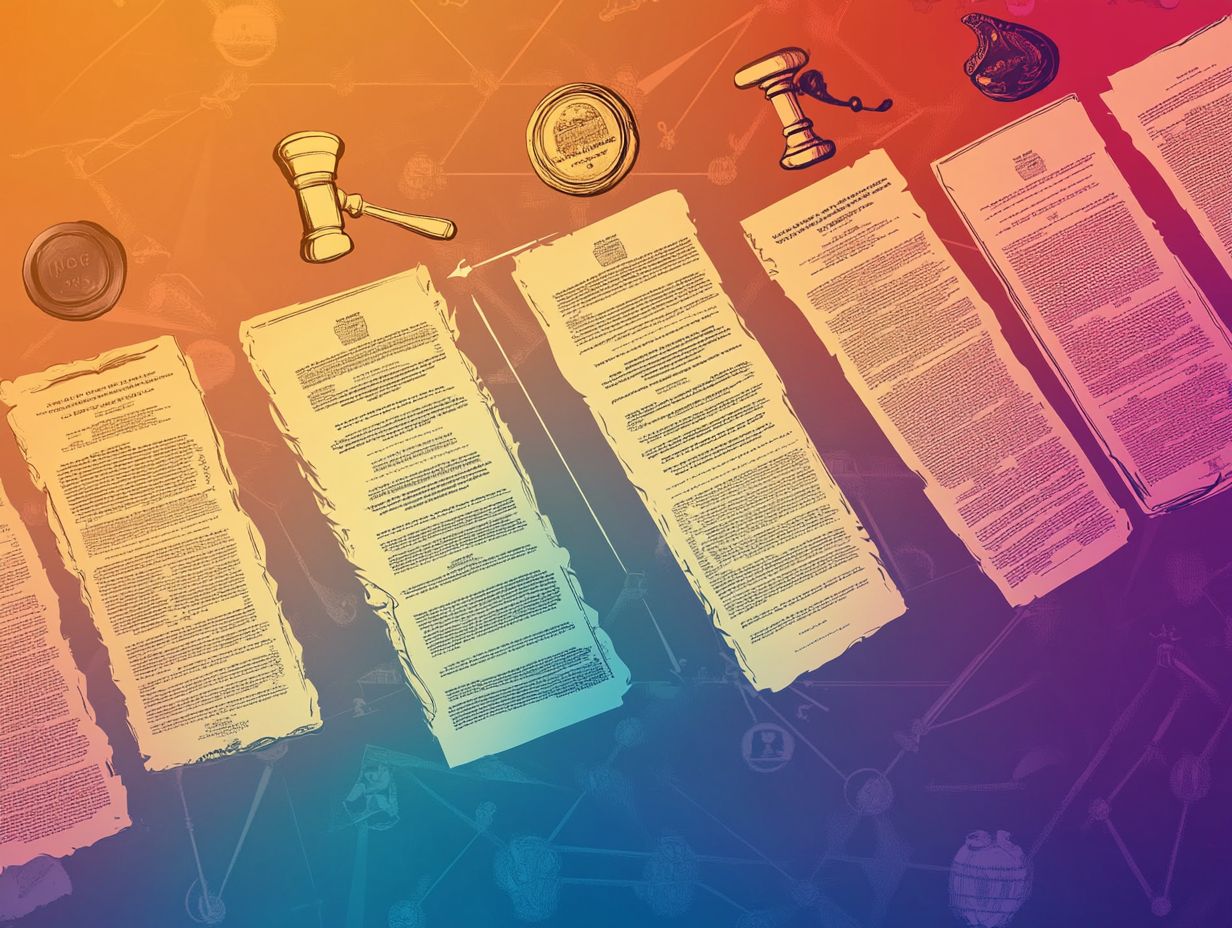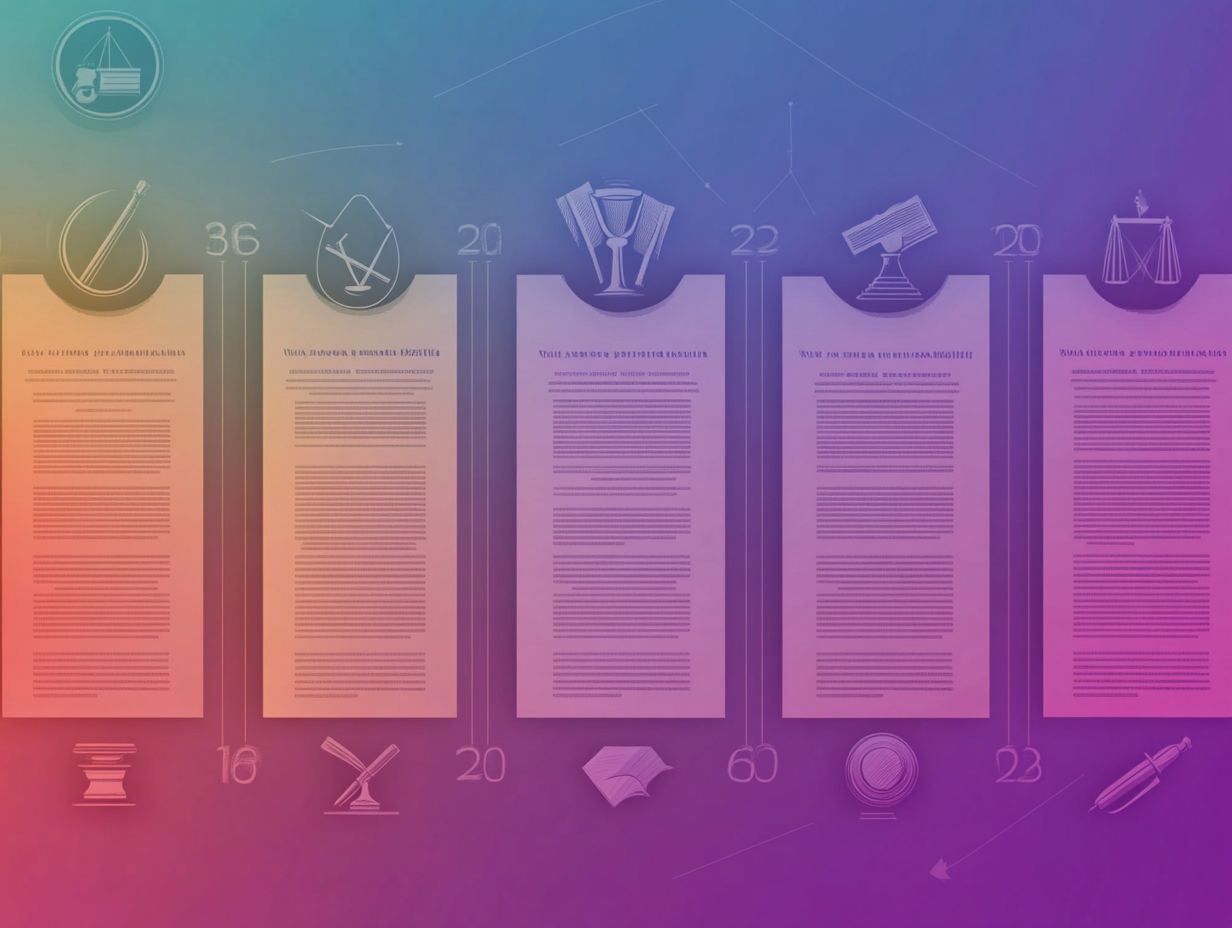The Evolution of Licensing Agreements Over the Years
Licensing agreements are essential in today s business environment. They enable companies to harness each other’s strengths while safeguarding their intellectual property.
Get ready to explore the foundations and evolution of licensing agreements! We will trace their historical roots and explore various types, from exclusive to international arrangements.
You ll discover key elements like terms, royalties (payments made for the use of intellectual property), and the influence of technology and globalization on modern practices.
Whether you re a business owner or just curious about the topic, this comprehensive overview will shed light on the complexities and trends that are shaping licensing agreements today.
Contents
- Key Takeaways:
- Overview of Licensing Agreements
- History of Licensing Agreements
- Types of Licensing Agreements
- Key Elements of a Licensing Agreement
- Current Trends in Licensing Agreements
- Frequently Asked Questions
- What is the meaning of licensing agreements?
- How have licensing agreements evolved over the years?
- What are some key differences in modern licensing agreements?
- Why is a well-structured licensing agreement important?
- How has technology influenced licensing agreements?
- What challenges might businesses face in licensing agreements?
Key Takeaways:

Licensing agreements have evolved significantly over the years. They have transformed from early forms of simple agreements to complex, specific contracts with detailed terms and conditions, especially considering the future of licensing agreements in a digital world.
The two main types of licensing agreements are exclusive and non-exclusive. Exclusive agreements give the licensee sole rights to the licensed product or service.
Licensing agreements can also be domestic or international. With the advancement of technology and increasing globalization, they have become more complex and face common challenges.
However, these challenges can be overcome through proper communication and clear terms and conditions in the agreement.
Overview of Licensing Agreements
Licensing agreements are essential legal contracts in the world of intellectual property. They give power to media companies like OpenAI and the Wall Street Journal to monetize their innovations.
These agreements not only protect their trade secrets but also ensure they receive appropriate compensation. By providing a structured framework for how intellectual property can be utilized and shared, they foster mutually beneficial relationships.
This includes specific terms regarding royalties, quality control, and mechanisms for dispute resolution. All these contribute to a balanced and productive partnership.
Definition and Purpose
A licensing agreement is a legal contract that gives you permission to use someone else’s intellectual property under specific terms, including compensation arrangements. These agreements are essential in the world of intellectual property law.
They allow the rightful owner to maintain control over their assets while enabling others to derive value from their use. By establishing clear guidelines, such contracts safeguard the interests of both parties.
This ensures that proprietary resources, such as trademarks, patents, and copyrights, are shared responsibly. You ll often encounter these agreements in scenarios like franchising, where a business model is replicated under a particular brand.
Software licensing grants you the right to use software programs while limiting modification or redistribution. Such arrangements pave the way for innovation and market growth.
History of Licensing Agreements
The history of licensing agreements has roots in important laws, notably the Statute of Anne in England. This landmark legislation established a framework for modern intellectual property law.
It gives power to creators from influential companies like Atlantic and Vox Media to safeguard their works through strategic licensing arrangements. Early licensing agreements trace back to this pivotal piece of legislation.
Early Forms of Licensing
These agreements established the legal framework for copyrights and patents. They allowed you, as an author or inventor, to exercise control over the use of your creations.
This landmark legislation ushered in an era where you could negotiate terms that protect your innovations from unauthorized use. During this period, licensing agreements became vital in ensuring that inventors could reap financial rewards from their work.
This fostered a culture rich in creativity and innovation. Take Benjamin Franklin, for example he was among the notable early adopters who utilized such agreements to safeguard his inventions.
These early agreements set the stage for modern licensing, balancing creativity with commerce.
Evolution of Licensing Agreements

The evolution of licensing agreements has been profoundly shaped by technological advancements and the diversification of intellectual property. To stay competitive, media companies must adapt their strategies, considering the future of digital licensing agreements.
Consider the rise of streaming services. It has dramatically transformed the entertainment licensing landscape. Companies are now compelled to negotiate exclusive content deals to entice subscribers and stand out in a crowded market.
In the software industry, the prevalence of cloud computing has shifted licensing from traditional perpetual models to subscription-based systems. This change allows users to receive regular updates and enhancements without constant purchases.
Trends in technology have led to innovative practices like open-source licensing. In this model, developers share their code with the community while retaining specific rights. These contemporary licensing strategies reflect a broader response to market demands and the essential need for flexibility in our rapidly evolving digital environment.
Types of Licensing Agreements
Licensing agreements can be classified into several distinct categories, primarily centered around their exclusivity exclusive versus non-exclusive and their geographical scope, whether domestic or international.
Each category carries its own implications for franchising and brand recognition, shaping the landscape in which businesses operate.
Exclusive vs. Non-Exclusive
Exclusive licensing agreements grant rights to utilize intellectual property as a sole licensee. Non-exclusive agreements allow multiple licensees to share those rights, each presenting unique advantages and challenges.
For example, in an exclusive agreement, a tech company might license patented software to just one manufacturer. This arrangement allows that manufacturer to dominate the market without competition, potentially creating a significant edge.
A non-exclusive agreement, on the other hand, permits several companies to leverage the same technology. While this fosters a collaborative atmosphere, it may dilute individual market share.
The financial implications of each agreement are significant. Exclusive licenses often demand higher upfront fees. In contrast, non-exclusive agreements may feature lower fees but open the door to recurring revenue streams through multiple licensees.
Understanding these dynamics is essential for businesses aiming to refine their intellectual property strategies.
Domestic vs. International
Domestic and international licensing agreements differ in their legal jurisdiction and governing laws. This significantly impacts how businesses protect and enforce their intellectual property across borders.
In domestic agreements, companies work within a familiar legal framework, making enforcement and compliance smoother. However, entering international markets presents distinct local laws and often unpredictable regulatory changes.
This added complexity can lead to challenges, such as differing interpretations of rights, potential litigation in unfamiliar courts, and the necessity to adapt to local business practices. These factors can hinder expansion efforts and complicate strategic planning.
Key Elements of a Licensing Agreement
The key elements of a licensing agreement include clearly defined terms and conditions, robust royalty structures, detailed payment schedules, and stringent quality control provisions.
These components are vital for protecting the interests of both parties, ensuring a mutually beneficial relationship.
Terms and Conditions

The terms and conditions of a licensing agreement lay out the obligations for both parties. They detail everything from the scope of use to payment responsibilities and the repercussions for breaching the contract.
Grasping the various types of terms and conditions available is essential for effective risk management.
- Defining the scope of use specifies how you can utilize the licensed material. Outlining payment obligations ensures you receive timely financial compensation.
- By detailing the rights granted such as exclusivity or territorial limitations you effectively safeguard your interests as the person receiving rights.
- It’s also vital to include potential penalties for non-compliance. These act as deterrents against violations and provide a clear resolution path.
When these terms are clear, they foster trust and pave the way for a successful partnership between all parties involved.
Royalties and Payments
Royalties and payments outlined in a licensing agreement serve as your compensation for utilizing creative works. Specific clauses detail how and when these payments are made, along with the consequences of failing to pay royalties.
Understanding the intricacies of royalty calculations is crucial for both the person giving rights and the person receiving rights. This knowledge enables effective navigation through these financial arrangements.
Often, these agreements are structured around various payment models like a flat fee, a percentage of sales, or a combination of both. They must clearly specify the formulas used to determine payment amounts.
Be mindful that late or missed payments can lead to potential legal issues and strained relationships between parties involved. Cultivating a culture of transparency in these transactions is crucial, as it ensures everyone has clarity regarding financial expectations and obligations.
Current Trends in Licensing Agreements
Current trends in licensing agreements highlight the profound influence of technology and globalization.
As you navigate this landscape, media companies are keenly adapting their strategies to enhance revenue generation and bolster brand recognition in an ever-evolving digital world.
Impact of Technology and Globalization
The influence of technology and globalization on licensing agreements presents exceptional opportunities for competitive advantage. You can effectively leverage your creative works across diverse markets.
By embracing digital licensing, you can streamline the process of granting usage rights, eliminate geographical barriers, and enhance your revenue streams.
Innovative tools and platforms now facilitate remote collaboration. This allows teams from various regions to work together seamlessly on product development and marketing strategies, maximizing the potential of your agreements.
Take, for example, major tech firms like Microsoft. They have adeptly established international partnerships that capitalize on localized adaptations of their software. This enables them to cater to specific regional needs while ensuring compliance.
These advancements not only boost operational efficiency but also open flexible pathways for growth in previously untapped markets.
Common Challenges and Solutions
Common challenges you may encounter in licensing agreements include dispute resolution, breach of contract, and ensuring compliance with statutory obligations. Addressing these challenges requires effective strategies for mitigation.
These obstacles can complicate relationships between parties and ultimately affect the success of the agreement. You and your team must actively engage in thorough contract negotiation to clearly define roles and responsibilities, minimizing misunderstandings.
Maintaining regular communication throughout the lifecycle of the agreement is a proactive approach. This allows you to address issues before they escalate. Implementing software solutions for contract management can streamline the process, ensuring that vital deadlines and compliance requirements are met efficiently.
By prioritizing these strategies, you can enhance collaboration and navigate challenges more effectively.
Frequently Asked Questions

Here are some common questions regarding licensing agreements.
What is the meaning of licensing agreements?
Licensing agreements are legal contracts between two parties. One party owns the rights to a product or technology and allows the other to use it for a fee.
How have licensing agreements evolved over the years?
Licensing agreements date back to ancient civilizations and have evolved significantly in scope and legal framework, especially as we explore the future of licensing agreements in a global market.
What are some key differences in modern licensing agreements?
Modern agreements include specific terms about intellectual property rights, which are the legal rights that protect creations of the mind, and technology transfer. They are also more detailed, covering areas like exclusivity, territory, and duration.
Why is a well-structured licensing agreement important?
A solid licensing agreement protects intellectual property rights and ensures fair compensation. It establishes clear guidelines, minimizing disputes.
How has technology influenced licensing agreements?
Technology has transformed licensing agreements dramatically. The rise of digital media led to new models like software-as-a-service (SaaS) and app store licensing.
What challenges might businesses face in licensing agreements?
Challenges include negotiating fair terms and ensuring compliance with legal regulations. Navigating these challenges is vital to safeguarding your business. Businesses should thoroughly understand all aspects before signing an agreement.






